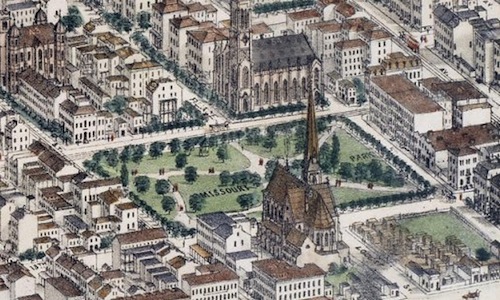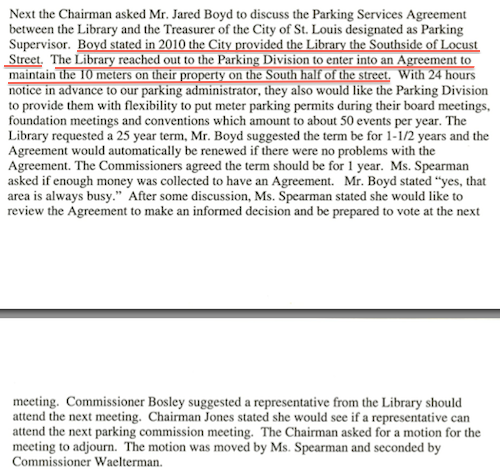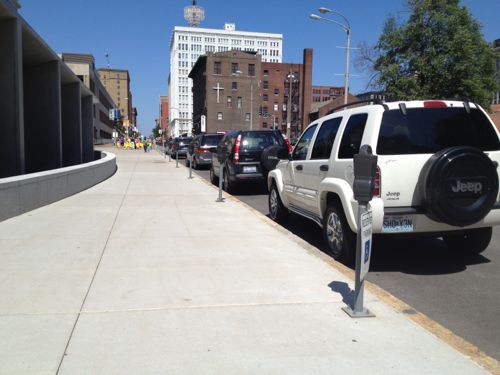Fragmentation: One Tiny Example That Reeks
The St. Louis region ranks second in the nation for fragmentation of government, resulting in negative consequences:
With each decennial Census since 1980, we find that more people are leaving the St. Louis region than moving in. We rank very low among competing metropolitan areas in job growth and in new business starts. We have not attracted the new immigrants that other metros have done in recent decades, and our demographic profile is much less diverse than that of regions that are growing. Economic and racial disparities create chasms within the regional family. Our governmental structure is second in the nation in terms of fragmentation. (East West Gateway)
Not good, right? Often cited is the 90+ municipalities in St. Louis County but last week I discovered a small example of governmental fragmentation within the City of St. Louis.
A parking meter issue related to the Central Library was voted on by the Parking Commission last week that required me to dig into St. Louis’ history from 156+ years ago to get some answers. Huh? Yes, I had to go back to two land transactions from 1857 to try to make sense of a modern day issue. I’m still not totally clear about the legality of a recent property boundary adjustment, but first let me set up the background for you.

We need to start with the history of the land bounded by Olive, 14th, St. Charles St., and 13th — today the site of the Central Library and Lucas Park. The old city website about Lucas Park had great information, good thing I saved it before it was removed:
Lucas Garden was the site of a brick house built by Judge Lucas in 1820 facing the present St. Charles Street or King’s Road, as it was called. There is still a flowing spring in the Public Library basement that was the water supply for the Judge’s home.
“Desirous of contributing to the ornament and health of the City of St. Louis and at the same time to establish a permanent monument to the memory of his ancestor (father) the late Honorable John B. C. Lucas, in the shape of a public square bearing his name,” reads the deed signed by James H. and Marie E. Lucas on March 24, 1857, giving the block of land immediately north of the St. Louis Public Library to St. Louisians. The deed states further that, “This conveyance is however made with the express condition, to wit: that said public square shall forever be maintained as a public promenade for the inhabitants of the City of St. Louis.”
On the same day in 1857 that he signed the deed on Lucas Garden, James H. Lucas sold the block where the Public Library now stands to the city for the sum of $95,000.
In 1859, a board of improvement for the park was created and its development started.
Its layout caused Locust Street to be closed at 13th and the park was given an asymmetrical plan with a bandstand near the foot of Lucas Place. Sale of the buildings at the southwest corner of the park was authorized by Ordinance in 1872. From the time of the first appropriation in 1858 to 1877, $41,465 was spent on it.
The entire 6.25 acres was named Missouri Park and provided popular downtown breathing space until the erection of the St. Louis Exposition and Music Hall in 1883. Licensed to a private corporation for a period of 50 years, the ground was restored to use as a park in 1907 and designs for the Italian Renaissance inspired library building were drawn up by the famous architect Cass Gilbert. The library was completed in 1912.
Locust Street was reopened behind the Library from 13th to 14th Streets and the present sunken garden with its fountain was developed. (source)
So the city bought the block where the library stands, but the land for the park to the north was a gift to the city, with conditions. With both parcels part being public land there shouldn’t an issue over boundaries. Shouldn’t, but there is.

“Their property?” The city “provided” land presumably part of the 1857 grant to the city to the public library, which then generously allowed the Treasurer’s office to keep parking meters located on the new moved sidewalk. Could citizens stage a protest on this sidewalk or would the library tell citizens it isn’t public property?
At the July meeting of the Parking Commission they voted to allow the library to “hood” the ten meters on library property up to 50 times per year for special events, including board meetings.

The next day I emailed all involved, informing them the library neglected to mention that two of the ten spaces are designated as disabled parking. Even if the parking meter is hooded, anyone parking in the space needs a legit disabled placard or plates. You can be sure I’ll be watching to see. Even so, I don’t like the idea of a disabled patron driving down to the library only to find every space on this side of the street taken by the library for board members.
A fragmented, reeking mess.
— Steve Patterson
Yes! . . . . Two words – charter reform! These turf battles do absolutely nothing to improve our city.
I wouldn’t argue that charter reform is needed…..and inevitable. But it isn’t going to solve every problem or create a state of utopia. And I really can’t see that charter reform would have addressed this parking issue at the Lucas property. Maybe I’ve not been around STL long enough to understand the nuances of STL City government, but from my perspective it appears to be just a convoluted mess, driven by self-serving aldermen and elected officials, some of whom could obviously not find work outside of city government. But I live in Clayton, the HUB of county government, which in my opinion is being run by a self-serving executive who also couldn’t find work outside of county government. So what’s the diff?.
Sorry, but I don’t view this parking issue as an example of “governmental fragmentation”. It appears to me that both the Treasurer AND a library directors simply might be unaware of previous covenants and agreements made regarding ownership and use of portions of the Lucas property. Nothing more. People make mistakes. How could any one person or office possibly be aware of every single agreement or decision that has been made over the past centuries? Be assured that, based on Treasurer Jones’ track record thus far, she’ll certainly make things right.
The library is very aware of the deed restrictions on the park. Even if they didn’t exist, the idea that one public entity (library) would threaten to displace parking meters operated by another public entirety (Treasurer’s parking division) from land obtained through a third public entity (city) is the point. The fact they’re separate makes them each territorial.
I understand and appreciate the point you are making…which is why charter reform is both necessary and inevitable. But charter reform is not going to address every future issue of conflict, nor will it eliminate interfering interests among separate municipal departments, which is why a strong mayor without yes-men will be needed when charter reform finally happens. But strong mayors typically emerge from vigorously-fought and legitimate campaign battles involving intelligent, perceptive and non-partisan candidates, which doesn’t appear to happen in STL (IMO) because mayors in STL appear to draw from only one political party….and they tend to represent only one of the two but not both of the racial groups that essentially comprise the city….another one of those “STL absolutes”! Doesn’t the average STL resident understand that the “other” political party might have some perceptive ideas that just might jar the city into a different mode/mindset/direction? My god, anyone who opens his eyes has to see a vision of “more-of-the-same” in STL’s future, unless attitudes change and “absolutes” are ignored.
I largely agree, but I’d prefer our municipal offices to be nonpartisan.
Charter reform sans a non-partisan stipulation would nearly be a waste of time. If we are going to modernise the charter lets not half-ass it.
Totally agree!!
How is that non-partisan stipulation enforced in the real world?
There is no party affiliation noted next to a candidate’s name on the ballot. In many cases, the party is known to those “in the know”, but isn’t so obvious to the casual voter.
…..all the more reason, then, to resume the charter reform movement in STL.
the same way it is everywhere else I’d suspect.
I hate to throw in a monkey wrench, but charter reform is useless if the citizens don’t get a voice in what is happening everywhere. The government largely ignores citizen voices, that will not improve with charter reform. Until, as a huge example, the McKee plans on the Northside are vetted among the populace then who really cares if there is 900, 90 or 9 muni’s in the St. Louis region?
The whole process is broken and Lucas Place is a small example of this fragmentation that would not change with a new charter.
There are more serious democratic and structural problems that underlie the political process. Problems that are not likely to change with charter reform. In fact I would say the same results will be a given, perhaps even worse, with charter reform.
If all property were lumped together as city (aka public) then it is al too easy to change the intent of that property. I remind you of the skirmish out in the St Charles (think it was 2 years ago) where a family donate land for use as a park and now the city wants to put cell towers up. The article also makes mention of a similar problem in St Louis County. http://www.stltoday.com/news/local/stcharles/plan-for–foot-tower-dismays-woman-who-sold-site/article_3b3ac244-ddb2-512b-b789-9800abba0211.html
Charter reform will do nothing to stop things like this, nor is government fragmented (at least in this case). It may seem like a lot of hoops to go through, but that is the beauty of it. It stops people that would otherwise destroy the intended purpose of said property.
Think of it this way….replace parking meter with cell tower. Would you still approve of a slimmed down government of a few people if they wanted to replace each meter with a cell tower? What if all the parks were deemed as common public property? Would you want a cell tower in Lucas Park? Forest Park? After all, they’re on a few public properties today. Think I’m nuts? then think of it this way…..would you want parking meters in Forest Park?
The only problem I see is that they want to cover the handicapped meters. I’m sure it is an oversight.
Denver is going through something similar, where the mayor / city council are in favor of swapping some dedicated park land with the school board. The city would get a downtown building (currently owned by the school board) and the school district would get a site for a new elementary school. Most neighbors who live near the current park are not happy. That said, Steve’s example really isn’t the same thing, it’s more about the arrogance of power, the idea that members of the library board should be entitled to free parking and for use of free parking as an incentive to patronize special events at the library.
It all boils down to who “owns” the street? The library or the citizens of St. Louis. If the library truly owns this section of the street (much like a private street in the CWE) and is contracting with the Treasury to manage “their” private parking, the library is free to direct the Treasury to do whatever it tells them to do. But if this is a public, city street, the Treasury should be managing parking to maximize both turnover and revenue, as it does everywhere else. What isn’t clear (to me) is “ownership”.
The roadway isn’t part if the new library boundary, but apparently the “public” sidewalk is. Not sure why they needed that much land.
It appears that Locust Street was narrowed and the new sidewalk installed on/over what was once a wider, public street. Unless there was an actual land transfer (“provided the south side of Locust Street” is very unclear), I would assume that the city, and not the library, still “owns” both the street and the sidewalk.